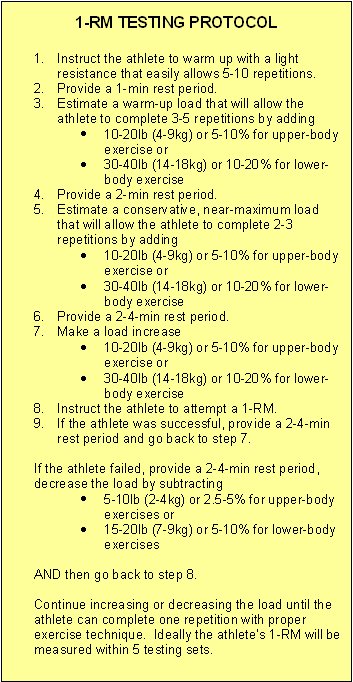Use these strength tests before you begin weight training and then periodically during your training program.
Maximal Strength Assessment (1-RM)
Strength tests to measure maximal strength are suitable for many athletes. For the reasons why maximal strength is important to athletic performance, see the strength training programs article.
The one repetition maximum (1-RM) is still considered the ‘gold standard’ of strength assessment by most coaches. The procedure usually consists of the bench press and back squat or leg press. These are compound movements incorporating most of the large muscle groups in the upper and lower body.
Either free weights or resistance machines can be used for the testing procedure but the choice should be determined by what the athlete intends to use during training. The specific adaptation to imposed demands means that a barbell back squat will more accurately determine the effectiveness of a free weights strength program than a machine leg press for example.
Testing Procedure
Here is the protocol for 1-RM testing as set out by the National Strength & Conditioning Association:

Results
Take your 1-RM weight for the bench press and leg press and divide it by your body weight. So for example, if you were able to lift 300lbs (136kg) on the leg press and you weigh 175lbs (80kg), that equates to a score of 1.7. Compare your score with the chart below…
| 1-RM Scores | |||||
| Bench Press | Poor | Fair | Good | Very good | Excellent |
| Men | 0.6 | 0.8 | 1.0 | 1.2 | 1.4 |
| Women | 0.3 | 0.4 | 0.5 | 0.6 | 0.7 |
| Leg Press | Poor | Fair | Good | Very good | Excellent |
| Men | 1.4 | 1.8 | 2.0 | 2.4 | 2.8 |
| Women | 1.2 | 1.4 | 1.8 | 2.0 | 2.2 |
The table below gives typical 1-RM scores for various groups of athletes:

Data from (1,2,3,4)
Alternative Strength Tests
Maximal strength tests do not have to consist of single lifts. A 10-repetition maximum may be more applicable and can be safer for weaker muscle groups such as the hamstrings.
Both sides of the body can be tested independently to compare muscular balance. For example a leg extension can be completed unilaterally for both the right and left quadriceps. The same principle can applied to compare agonists and antagonists – i.e. completing a leg extension and leg curl test and comparing the strength ration. The table below gives a guideline for strength ratios between opposing muscle groups:

Strength Endurance Assessment
The following two strength tests measure muscular endurance. The standard exercises used are push ups and sit ups. Again, these can be adapted. Seated rows may be more applicable for a rower for example.
The score is simply determined by the number of repetitions completed in one minute.
For a sit up to qualify you must place you hands to the side of you head, bend your knees and keep your feet flat on the floor. Your elbows must touch your knees and someone should hold your feet for support.
Results
Check your score with the table below:
| Push Up & Sit Up Scores | |||||
| Sit Ups | Poor | Fair | Good | Very good | Excellent |
| Men | 20 | 30 | 40 | 50 | 60 |
| Women | 20 | 30 | 40 | 50 | 60 |
| Push Ups | Poor | Fair | Good | Very good | Excellent |
| Men | 10 | 20 | 30 | 40 | 50 |
| Women | 10 | 20 | 30 | 40 | 50 |
*The scores for women’s push ups are based on the modified push up – i.e. placing your weight on you knees instead of your toes.
References
1. Berg R, Latin RW, Baechle T. Survey of physical fitness of NCAA Division 1 football players. NSCA J. 1992, 14(3):68-72
2. Baechle TR and Earle RW. 2000 Essentials of Strength Training and Conditioning: 2nd Edition. Champaign, IL: Human Kinetics
3. Schweigert D. Normative values for common preseason testing values: NCAA Division II womens basketball. NSCA J. 1996,18(6):7-10

Jacky has a degree in Sports Science and is a Certified Sports and Conditioning Coach. He has also worked with clients around the world as a personal trainer.
He has been fortunate enough to work with a wide range of people from very different ends of the fitness spectrum. Through promoting positive health changes with diet and exercise, he has helped patients recover from aging-related and other otherwise debilitating diseases.
He spends most of his time these days writing fitness-related content of some form or another. He still likes to work with people on a one-to-one basis – he just doesn’t get up at 5am to see clients anymore.